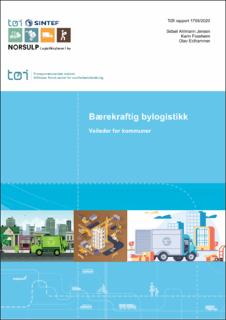| dc.contributor.author | Jensen, Sidsel Ahlmann | |
| dc.contributor.author | Fossheim, Karin | |
| dc.contributor.author | Eidhammer, Olav | |
| dc.coverage.spatial | Norway | en_US |
| dc.date.accessioned | 2020-10-13T10:53:06Z | |
| dc.date.available | 2020-10-13T10:53:06Z | |
| dc.date.issued | 2020-03 | |
| dc.identifier.uri | https://hdl.handle.net/11250/2682439 | |
| dc.description.abstract | Denne rapporten er en veileder for norske bykommuner i arbeidet for å få en velfungerende og klima- og miljøvennlig bylogistikk. Dette er første versjon av en veileder for bylogistikkplanlegging i Norge. Bylogistikk - transport av varer, utstyr og avfall - er viktig for utviklingen av levende og bærekraftige byer. Dette har hittil vært viet lite oppmerksomhet i planlegging og politikkutforming i norske kommuner. Det er behov for å integrere bylogistikk i kommunale planer og strategier, sikre koordinering på tvers av sektorer internt i kommunen og styrke medvirkning med næringslivsaktører. Bylogistikk må sees i sammenheng med andre trafikantgrupper og brukere av byrom. Veilederen beskriver sentrale utfordringer, utviklingstrekk, varekjeder og aktørgrupper innen bylogistikk, og fremgangsmåter til hvordan kommuner kan bidra til en mer bærekraftig bylogistikk. Dette omfatter virkemidler som kommuneplanens samfunnsdel, bylogistikkplan, arealplanlegging, medvirkning med næringslivsaktører, situasjonsanalyse, innkjøp av varer og tjenester, samt vintervedlikehold. I tillegg beskrives eksempler på tiltak som bylogistikkdepot, samleterminal og ladeinfrastruktur. | en_US |
| dc.description.abstract | This report is a guide for Norwegian municipalities to work towards a well-functioning and climate and environmentally friendly urban logistics. This is the first version of a guide for sustainable urban logistics planning in Norway. Urban logistics – the movement of goods, equipment and waste - is important for the development of vibrant and sustainable cities. So far, little attention has been paid to planning and policy formulation on this topic in Norwegian municipalities. There is a need to integrate urban logistics into municipal plans and strategies, ensure coordination across municipal sectors and strengthen participation with business. Urban logistics must be seen in relation to other forms of transport and users of public spaces. The guide describes key challenges, trends, supply chains and stakeholder groups in urban logistics, and presents approaches to how municipalities can contribute to more sustainable urban logistics. This includes instruments such as the municipal master plan, sustainable urban logistics plan, land use planning, participation with business, procurement of goods and services, and winter maintenance of public spaces. In addition, examples of measures such as urban logistics depot, consolidation center and charging infrastructure are described. | en_US |
| dc.description.sponsorship | Statens vegvesen | en_US |
| dc.language.iso | nob | en_US |
| dc.publisher | TØI Transportøkonomisk Institutt | en_US |
| dc.relation.ispartofseries | TØI rapport;1755/2020 | |
| dc.rights | Attribution-NoDerivatives 4.0 Internasjonal | * |
| dc.rights.uri | http://creativecommons.org/licenses/by-nd/4.0/deed.no | * |
| dc.subject | Bylogistikkplan | en_US |
| dc.subject | Varelevering | en_US |
| dc.subject | Medvirkning | en_US |
| dc.subject | Kommunale tiltak | en_US |
| dc.subject | Bylogistikk | en_US |
| dc.title | Bærekraftig bylogistikk - Veileder for kommuner | en_US |
| dc.type | Report | en_US |
| dc.rights.holder | TØI Transportøkonomisk Institutt | en_US |
| dc.source.pagenumber | 54 | en_US |

